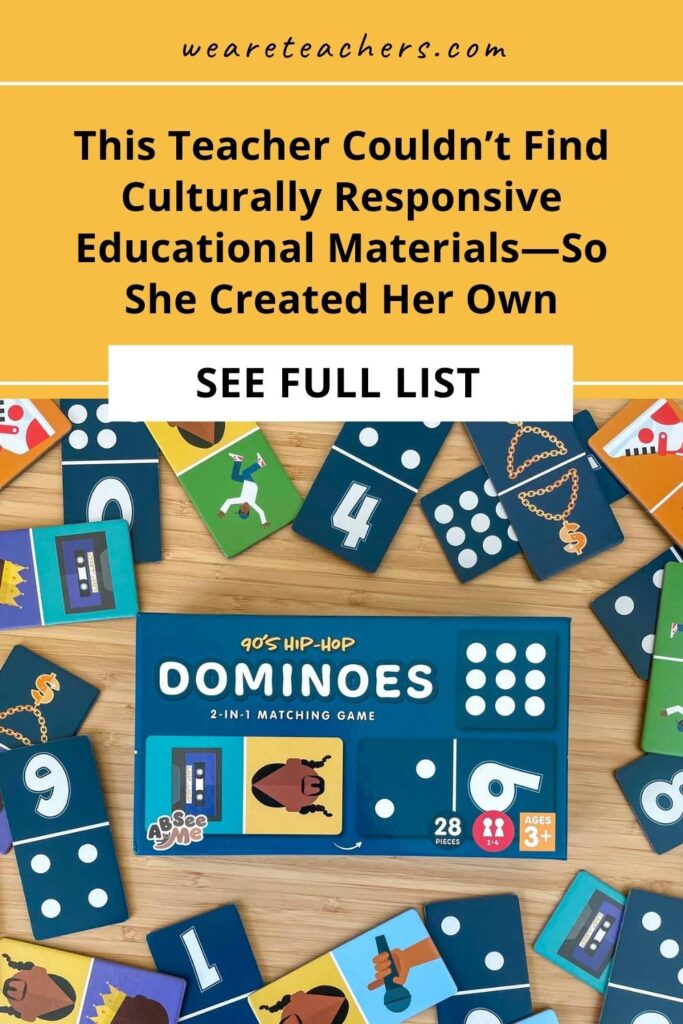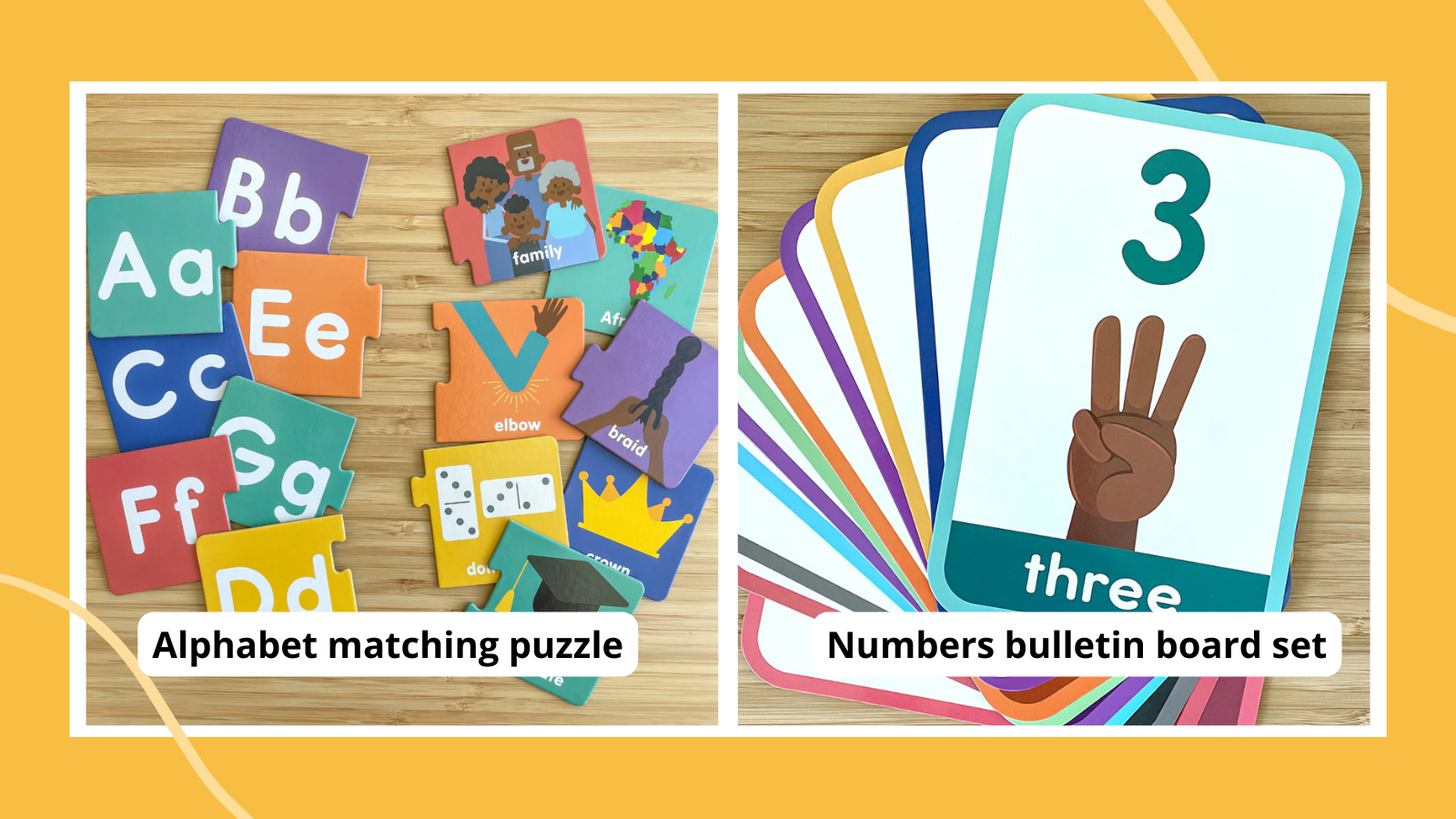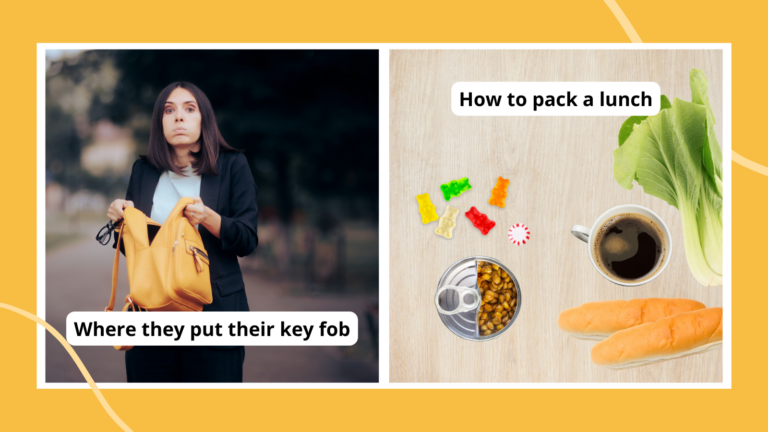Christina Spencer is not the type to settle for “good enough.” So when she saw that her students’ experiences, cultures, and personhood weren’t reflected in the educational materials in her classroom, she didn’t shrug and say, “Oh, well. I guess I’ll have to make do without culturally responsive educational materials for my students.”
Instead, she made them herself.
Christina founded ABSee Me, an early childhood education resource company dedicated to creating culturally responsive and relevant materials for toddlers through early elementary. We were blown away by the products in her shop—a reversible Black mermaids counting puzzle(!), ’90s hip-hop dominoes, and stunning bulletin board sets.
Knowing the importance of culturally responsive teaching, we reached out to learn more about her company and her story.
Can you tell us about your teaching background?
I’ve been in education for well over a decade now. Teaching is in my blood, you could say. My sister is a teacher, my dad was a teacher, and it was always like a natural calling for me, leading me to pursue a bachelor’s degree in Human Ecology and my master’s in Early Childhood Education.
Throughout my career, I’ve had the opportunity to wear different hats in education, starting as an elementary classroom teacher and then taking on roles as an instructional coach and a curriculum specialist.
My journey in education has also taken me to the Middle East, where I immersed myself in different educational systems and cultures. Working in the United Arab Emirates played a pivotal part in preparing me for this new type of educational role that I embrace today as the founder of ABSee Me.
What experience(s) led to you founding ABSee Me?
During my last couple years of teaching in the U.S., I was teaching a cluster of English-language learners and struggled to find resources that reflected the cultural diversity found in my classroom. It became evident to me that there was a lack of educational tools that represent and celebrate the unique backgrounds and experiences of children of color.
So when I couldn’t find those resources myself, I rolled up my sleeves and got creative. I started crafting things myself to make sure that each of my students could see themselves in our classroom in my teaching materials.
Years later, when I moved to the UAE, I faced a similar challenge. Most of my students were local Emiratis, living in a country with a unique Muslim culture. But believe it or not, my school followed U.S. Common Core Standards, and the teaching resources I received for math and literacy were all U.S.-based programs, reflecting American culture. Many of the activities and topics didn’t resonate with my Emirati learners. They needed something more relatable, something that spoke to their own experiences.
So again, I used my creativity to fill that gap. We delved into their own currency, dirhams, rather than focusing on nickels and dimes as the math books suggested. When it came to making graphs about our favorite pets, I ditched the typical options like dogs and cats and brought in culturally significant choices like camels and falcons. These were the “pets” that mattered to them. It was all about making learning meaningful and relevant for them.
Before developing your resources, what kinds of things did you do to make sure your students were represented in your classroom?
Creating an inclusive classroom environment was a top priority for me. Right from the start of the year, I used an “All About Me” assignment to get insights into my students’ home life, culture, and interests. It helped me start tailoring my lessons to incorporate their experiences while I built genuine relationships and got know them deeper throughout the year.
A diverse classroom library was a must, so I actively sought out books that showcased their unique backgrounds and featured diverse characters.
For my English-language learners, I had a special area in the classroom that displayed important words from their language, like greetings, which helped me connect with them on a deeper level.
During activities, I always made sure to include culturally relevant topics. For instance, in a nonfiction writing unit I did in the U.S., we explored Ramadan, allowing me to seamlessly integrate culture and a topic that was very important to some of the students in my class, while modeling essential skills like how to write an introductory paragraph.
The visual aids, presentations, and math story problems I created always showcased diverse characters and included real-world examples whenever possible.
And when it came to adapting activities and resources, I made sure they were relevant to my students, like when we studied the Burj Khalifa instead of the Statue of Liberty with my Emirati students. It allowed them to connect with the subject matter personally and made our lessons more meaningful.
How did your students respond to seeing themselves in your teaching materials?
When I made a genuine effort to ensure that my students saw themselves represented in our learning environment and materials, amazing things happened. Their level of engagement skyrocketed when we explored topics they could personally relate to or discussed subjects that held significance for them. It was heartwarming to witness their “lightbulb” moments as they made deeper connections with the material.
Seeing their faces light up with pride and recognition when they encountered their own names or characters resembling them in books or activities was truly special. It created a sense of belonging, confidence, and pride. It’s moments like those that remind me of the importance of inclusive teaching and the impact it has on students’ lives.
How did you combine your training, experience, creativity, and vision in developing a product?
When I design materials, I honestly just think about what would have made a difference for me and my students when I was in the classroom. I think about the things that would have truly connected with them and kept them engaged. But beyond connection, I look for ways to help kids tackle critical early childhood skills.
As a former educator, I try my hardest to make my materials versatile and practical. For example, my bulletin board sets are laminated and can be easily hung on the wall, but they can also be used in literacy centers for tracing and letter formation or in sorting activities.
To stay connected with teachers’ needs and the evolving field of education, I actively participate in teacher groups on Facebook, listen to educational podcasts, and stay updated on current trends. This helps me develop materials for what today’s teachers and students need.
Which resource(s) would you recommend as a starting point for teachers to build a more culturally responsive classroom?
When it comes to using my products to build a more culturally responsive classroom, the choice really depends on the makeup and skill level of the students in a teacher’s class. For example, if they have African American students and are working on letter sounds or counting, or even just want to expose their learners to other cultures, I would definitely recommend starting with our Black culture–inspired Alphabet Puzzles or our ’90s Hip-Hop Counting Dominoes. These resources provide a fantastic opportunity to connect learning with culture in the classroom.
Our bulletin board sets are an excellent starting point for building a more culturally responsive classroom as well. These versatile cards cover a range of topics such as the alphabet, 2D shapes, beginning blends, and more. They can be utilized in small-group activities or hung on the walls to serve as reference charts for kids.
What sets our bulletin board sets apart is their inclusion of diverse characters, providing an opportunity for learners of color to see themselves reflected in the physical classroom environment. Incorporating our bulletin board sets into the decor can help teachers set the tone for a classroom where all students feel seen, celebrated, and valued.
What’s been the most meaningful story or feedback you’ve heard from a customer?
It’s so tough to choose just one! Every single day, I get messages filled with gratitude and warm wishes from complete strangers who express their love for my products and share how they wish they had access to resources like mine during their own childhood. It’s humbling to know that my work resonates with so many people and addresses a gap that still exists in education today.
What touches my heart the most, though, is when I see videos sent by customers of a Black or Brown child using my products and joyfully exclaiming, “That looks like me!” Those moments never fail to bring a tear to my eye because they validate the very essence of why I do what I do.
My ultimate goal is for children of color to see themselves represented in my learning products and feel an immense sense of pride when they use them. It’s these powerful moments that remind me of the impact and importance of inclusive educational materials. Representation truly matters.
Be sure to check out the ABSee Me shop. And to learn more about culturally responsive teaching, we recommend this book, these lesson plans for creating inclusive communities, and this article on why you need to see color in your classroom.
Which ABSee Me product are you most excited to try? Let us know in the comments!
Plus, for more articles like this, be sure to subscribe to our newsletters.


